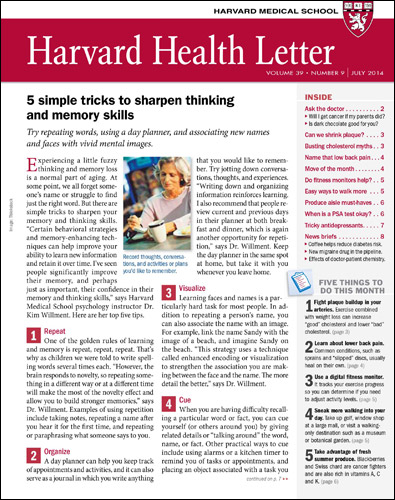Harvard Health Blog
Quick injection helps stop epileptic seizures
ARCHIVED CONTENT: As a service to our readers, Harvard Health Publishing provides access to our library of archived content. Please note the date each article was posted or last reviewed. No content on this site, regardless of date, should ever be used as a substitute for direct medical advice from your doctor or other qualified clinician.
An epileptic seizure is a frightening thing to experience, and almost as frightening to watch. The person loses consciousness and falls to the ground. His or her muscles contract in spasms, causing uncontrollable jerks and twitches. Spasms of the jaw muscles can cause the person to bite his or her tongue. Breathing becomes difficult, and may even stop briefly. Seizures cause some people to lose control of their bladder or bowels.
Fortunately, most seizures stop on their own after a couple minutes. Any that last longer than five to 10 minutes (doctors call such long-lasting seizures status epilepticus) are a medical emergency and must be halted with medication administered intravenously by a doctor or emergency medical technician. More than 50,000 people in the United States die from prolonged seizures every year, either from brain damage due to the seizure itself or from accidents related to passing out mid-attack.
A study published last week in the New England Journal of Medicine indicates that a hand-held auto-injector—much like the epi pens used by people with life-threatening allergies—could be used to treat seizures that don’t stop on their own. This could pave the way for home treatment of epileptic seizures.
Muscle trumps vein
For the trial, more than 4,000 emergency medical technicians were trained to administer seizure-stopping drugs called benzodiazepines two ways: through an intravenous line inserted into a vein in the arm (the current standard treatment), and with a device that automatically injects the drug into the thigh. Intravenous administration works faster, but it can be hard to put an intravenous line into the arm of someone having a seizure. Injection into the thigh takes effect a bit more slowly, but is far easier to do.
Over an 18-month period, emergency medical crews responded to 893 long-lasting seizures. Half of the people in status epilepticus received a benzodiazepine intravenously, the other half by thigh injection. The muscle injection worked faster and better. It stopped the seizure in 73% of the people before they arrived at the hospital. The intravenous route stopped the seizure in 63%.
Minutes matter
Seizures that end quickly don’t damage the brain. Those that last longer than five minutes can cause permanent brain damage and disability. The longer a seizure goes on past 10 minutes, the harder it is to stop it with medication. And up to one in five people die from a long-lasting seizure. So the sooner an anti-seizure medication can reach the brain, the better.
If you ever witness a seizure, stay calm and do your best to keep everyone else calm. Here are some steps you can take:
Call 911, or have someone else do it.
Time the seizure. This information will be helpful when the emergency medical crew arrives. Try to remember as many details as you can to tell the paramedics and doctor later.
Provide support. Don’t try to hold the person down or force anything into his or her mouth, even if the tongue is bleeding. To prevent head injury, gently position a soft, flat object like a jacket under the head. Remove any hard or sharp objects that are near the person.
When the jerking stops, gently roll the person onto his or her side. When the person wakes up, be reassuring and provide transportation or other help that may be needed.
Looking ahead
This one study isn’t the green light for doctors to give auto-injectors filled with anti-seizure medication to all of their patients who have seizures. With further testing for safety, though, that is likely to happen. This could spare these people and their families the agonizing wait for an ambulance to arrive in order to halt the seizure. Proper education on the use of these injectors will also be important.
In addition to auto-injectors, researchers are also testing a nasal spray containing a benzodiazepine. This could deliver the medication to the brain even faster than an auto-injector.
About the Author

Howard E. LeWine, MD, Chief Medical Editor, Harvard Health Publishing; Editorial Advisory Board Member, Harvard Health Publishing
Disclaimer:
As a service to our readers, Harvard Health Publishing provides access to our library of archived content. Please note the date of last review or update on all articles.
No content on this site, regardless of date, should ever be used as a substitute for direct medical advice from your doctor or other qualified clinician.
















